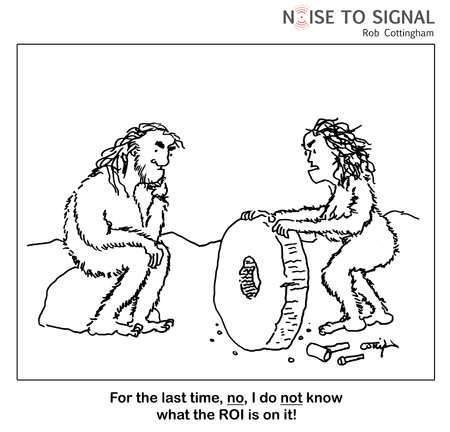Big Data is a big topic these days. Hype? We don't think so.
Nor does a recent Wall Street Journal article titled “So, What's Your Algorithm?”
Consider this: a petabyte is equal to one quadrillion bytes, or 1000 terabytes. The banking industry alone stores over 600 petrabytes of information. Health care providers store over 400 petabytes. Professional services? Over 400 petrabytes.
Thanks to cloud computing we can now harvest and analyze massive amounts of information from multiple databases to make better business decisions - something not possible as recent as a few years ago. This is Big Data analytics and it’s about to change your world. Cloud computing makes it possible to handle big data and help us reduce human biases from our decision-making.
It means fewer hunches and more facts.
Take the Schwan Food Company. The WSJ article talks about how Schwan’s home delivery sales were listless for four straight years – until they started using data analytics. Now, they are sending more than 1.2 million dynamically-generated customer recommendations every day and matching seemingly disparate customers with similar purchase patterns in their past. Sales are rising.
The CEO of the data analytics firm they work with says, "A few years ago it might take a month to run a project involving 30 billion separate calculations. Today it can be done in two to three hours."
Another example in the WSJ article comes from the Rx industry: "Soon, a drug saleswoman will have real-time analytics that tell her to focus on the doctors who spent time on social networks that morning, and who are thus more apt to influence colleagues.”
The predictive power of Big Data is enormous -- and just beginning to be understood. Consider this: researchers using data analytics found a spike in Google search requests for terms like “flu symptoms” and “flu treatments” weeks BEFORE there was an increase in flu patients coming to hospital emergency rooms in a particular region.
What about Big Data in the human capital space?
In his article “Get Your Head Out of the Clouds (and into Big Data)” Jason Averbook states that most organizations utilize less than 5% of available data because the rest has been too costly to access or effectively utilize. Jason writes that HR functions today have approximately 10,000% more data than they had only 3-5 years ago and that Big Data will give employers the tools and techniques to affordably exploit the other 95%.
This means better hiring decisions, better allocation of human capital, better talent management, better rewards and recognition, better compensation and benefits, better productivity – better everything that relates to the recruiting, retention, management and use of people.
HR thought leader John Sumser, who was recently named a top 20 Big Data influencer by Forbes says this about Big Data and HR: "A universe of sensors will blow the lid off of HR as we know it."
OK – this is a marketing blog so let’s talk about what Big Data means for marketing and PR departments in the HR space. Big Data analysis is a lot more than just measuring your "social footprint" or monitoring who's talking about your brand.
To make the point, let's leave the clouds and get down into the weeds of media relations.
Too many in this profession assume they know who to reach out to with their latest pitches. They blast announcements the same way they did five years ago – to a tired, stale distribution list – or worse, they post it to a press release wire service and walk away. More savvy PR pros will share the news on their social channels and maybe send a few personal "pitches" to journalists, analysts and others. They typically aim at their same small universe of contacts. But these pleas for recognition are rarely targeted and often have little impact.
Until recently, there was no choice. Too much data and not enough time – or technology – to make much sense of it. Social media only compounds the problem.
Enter big data.

Noise to Signal Cartoon
Now, in near real-time, you can custom build targeted "lists" (which change daily) to include only those who share an interest and are influencing the topics or news you want to talk about. This includes many people you’ve likely never heard of before. And you can slice and dice the information in a variety of ways. Our SocialEars software is an example of a technology that allows this level of insight.
But this is just a small sliver of how Big Data will help marketers. Similar to how it impacts HR management, it also impacts all aspects of marketing: Pricing, Promotion, Product and Place.
The implications for sales departments are equally huge. Imagine being able to monitor the online "social" activity of your prospects to see what they most frequently talk about, learn their product needs, or the events they plan on attending? Again, technologies like SocialEars make this possible.
This is Big Data and it’s a Big Deal for marketing and PR departments.
In his blog post, Jason Averbook wrote:
“OK, it’s official. I’m calling it right now. I am betting ‘Big Data’ will unseat ‘Cloud Computing’ as the top buzzword in 2012 that will get HR people talking. Any takers?”
I'm a taker, Jason. And I'll make my own call (at least the first time publicly): I am betting “Big Data” will be the top buzzword in 2012 that gets marketing and PR people talking. Any takers?
By the way, if you’re interested in this topic (as it relates to marketing and PR), join the Social Listening Analytics Group at LinkedIn:
Post by HRmarketer / SocialEars Founder and CEO Mark Willaman. Join Mark on LinkedIn and Twitter.Labels: big data, Social Analytics, social listening software, SocialEars
